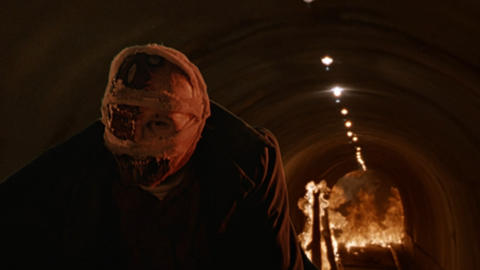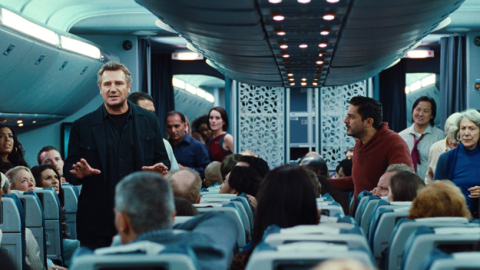Interview: Jaume Collet-Serra
Working unobtrusively but consistently in a decadent Hollywood that’s doubled down on sci-fi/fantasy/superhero franchise tentpoles as the end-all-be-all of action movies, Jaume Collet-Serra has been diligently and often ingeniously pursuing another filmmaking model, that of the mid-range budget standalone genre picture. A native of Catalan who relocated to Los Angeles at 18, Collet-Serra had a precocious rise through the commercial and music video directing ranks that caught the attention of producer Joel Silver, leading to his first feature gig on 2005’s House of Wax, which this dewy young critic at the time described as “an adroitly shot inventory of perversities, bustling with inventive murder and anchored by Brian Edmonds’s great, creepy sets.”
Apologies for the awkward proximity of “inventory” and “inventive.” I’ve been learning on the job since, and so has Collet-Serra, a get-down-to-brass-tacks director working in the populist, popcorn mode without an ounce of either pomposity or condescension, achieving no small measure of artistic and financial success on his own terms in so doing: his surfer vs. shark survivalist tale The Shallows, for example, hauled in six times its slim production budget in 2016. Setting aside this and the singular accomplishment of Collet-Serra’s Orphan (2009), one of the more authentically depraved horror-thrillers of recent memory, the defining factor in his career has been an ongoing partnership with Liam Neeson, with whom he has worked on four films, each a highlight of Neeson’s late turn as an action superstar: Unknown (2011), Non-Stop (2014), Run All Night (2015), and now the hard-charging The Commuter, out this week.
Before embarking on his next film, a vehicle for the Rock titled Jungle Cruise, Collet-Serra talked to Film Comment about his latest, as well as about the movies that brought him to this point, poised somewhere between a cult director and a bona fide power player.
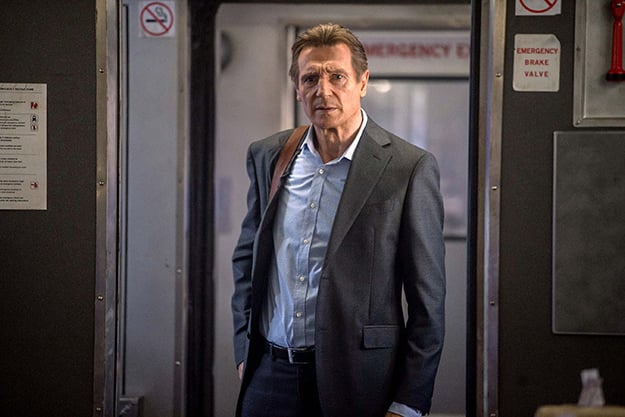
The Commuter
Could you tell me something about the genesis of The Commuter?
It’s a movie that has a lot of past collaborators: producers Steve Richards, Andrew Rona, Alex Heineman have worked with me on Non-Stop, and of course Liam. We enjoyed the process of making that movie—or at least I personally really enjoyed it, and enjoy making movies all in one environment. But Non-Stop also had a mystery element to it, a little bit of an Agatha Christie, find-the-suspect element. So after Non-Stop I wanted to find more material like that. We even talked about potentially doing a sequel to Non-Stop and trying to replicate the experience for an audience. But we thought we had said everything we had to say about the characters of Non-Stop. And then when this screenplay showed up, we saw an opportunity to do a spiritual sequel, a similar experience for the audience, but with different characters and different challenges.
The original script was not all in one environment, with different perspectives back in the city and showing other things happening. But because I really like to keep things focused, I tried to change things so that it all happened on the train as much as possible. With these changes I got really excited about the project. After The Shallows, working with only a handful of characters, I enjoyed working with a big cast and the train gave me the opportunity to have 40-some characters, working with a lot of really talented actors. As a director I could begin by taking the point-of-view of Liam’s character and then move beyond, exploring the environment and everyone around him.
You pay a lot of attention to point-of-view and like to play around with it. Non-Stop opens with the camera’s perspective very much aligned with that of Neeson’s character, right down to the hangover bleariness, and then you open it up and complicate it from there. This seems like something that you think about a lot.
Yes. I enjoy this in thrillers, and I really enjoy putting the audience in the main character’s shoes, giving them the same amount of information as the character, so they’re there with the main character making all the decisions. In a way it makes the audience a participant, and they can choose to agree or disagree with each of the decisions that the character makes. That why Liam is so compelling in these kinds of roles, because without much exposition you can immediately get to know him. He just has this incredible gift: playing different characters, you recognize him instantly. And that’s why I love working with Liam. I can put him in any situation, and not only is he instantly likeable, but the audience knows who he is right away without my having to explain too much. But of course every character he’s done for me is different, and I’m always very surprised at what I see on the first day of shooting.
In The Commuter we wanted him to be more of a regular guy, a good man who has worked hard for his family and is a good father. And his only drawback, if you want to call it that, is that he’s 60 and society is telling him that they don’t need him anymore. But that’s not necessarily how he feels. He still feels like he has a lot to give, but that’s something that eventually will come to all of us, you know, where we have to give up our place and be replaced within the machine. So the audience can relate to that. They can also relate to him trying to do the right thing, which is what he’s doing for the entire movie. In the other movies I’ve done with Liam his character is always starting from a low point from which he has to redeem himself. So it was a bit refreshing to start from a different point here, having him be a protector in a different way. Like we all do going to work every day, just trying to provide for the family. And every day we’re trying to make the right decision, and sometimes the decisions we make can jeopardize what we’re working for. And in order to do that, yes, I really focus on the point-of-view. So, visually, it is very important for me to know who I want the audience to be, and this can be as simple as going from close-up of someone looking to what they see, or constantly finding unusual points of view. I think that that’s what makes a thriller thrilling, rather than being a voyeur.
You don’t have a screenwriting credit on any of your films, but when I look at the filmography in total it reflects a coherent set of interests, both thematically and visually. I wondered if you could talk a little bit about how you shape your material? Is it a matter of people knowing what sort of material you’re interested in at this point, and bringing it to you readymade?
As a director, you have, obviously, a lot of power over every aspect of the movie. You can really prepare your vision. And not everything that ends up on the screen is written—obviously there’s the dialogue and the setting and whatnot. But there’s also the way things are shot, the lenses you’ll use and the light, all of those things. In the screenwriting, I do a lot to get into the script, and try to come to the essence of the movie. And I give myself a lot of restrictions, because I feel that restrictions are a good way to maintain clarity in a movie like this one. For Non-Stop, I kept cutting to other people in other environments, and this creates a potential for people to get confused as to what the movie is about. Am I doing a commentary on air transportation, a commentary on this or that? But by keeping the movie very focused in one environment, keeping the action in one place, the environment fades away, at some point you stop seeing the train, you stop seeing the plane. You look at the people, like you would in a play. And that way I’m able to get things across more purely.
I work generally with similar writers, but I like structure. I don’t consider myself a writer at all. I speak English but I couldn’t write a line of dialogue. But I think that everything in film is rhythm. Rhythm is structure, it’s editing, music, the pacing of the shot. I think I have a sort of instinct for that and I can really help early on with the script—I can get a sense whether a scene doesn’t belong where it is or could be combined with another scene to move things along. That’s my basic job at that stage. Later, directing creates the possibility to make everything my own, in many regards. But for the writing, that’s mostly what I do, the structure.
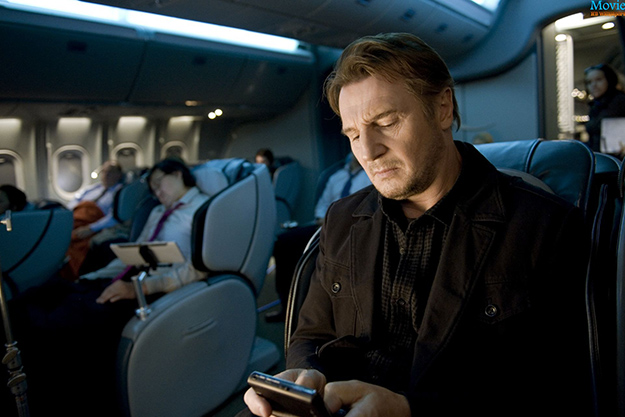
Non-Stop
What’s your prep process? Do you have the movie in your head when you go to set? Are you a big storyboarder?
Storyboards are not for me—meaning that the goal of the storyboard is for the rest of the crew to know what I want to do. And these days, we have different tools for big sequences in premix where we can sort of animate the action. I think that is a better tool these days to do the train crash in The Commuter, for instance. Yeah, we can start with some storyboards, but eventually, we will have to have some crude 3D animations done that will help the crew even better to prep for it. Now, for everything else, I don’t storyboard at all because I don’t need it. The crew doesn’t need it, either, because we are in the same train carriage that we were yesterday, and with the same equipment, we don’t need to know exactly where the camera is going to go. We have everything that we need, so I don’t need it.
With a lot of visual effects, the storyboards is the first step to the effects premix. In The Shallows, I did a lot of it. I storyboarded the whole movie. But that was a movie that had very little dialogue, so that was a very different thing. Because you could have half a page of Blake Lively on top of that rock, and that could be either an hour of shooting, or three days of shooting, depending on how I shot it. So I storyboarded that, again, since it was all blue screen, we didn’t have the limitations of the location. So then we basically needed to tell the crew: “This is what we’re doing today.” It’s just a tool for that, for them, but not for me personally. I personally like to write all the shots down, at first, so that they’re in my head.
I’m always impressed with the attention that you pay to credit sequences, both opening or closing. I’d just like to ask you a little bit about the conception of the opening for The Commuter, which starts out seeming as though you might be opting for the most generic opening for a movie possible—main character waking up in the morning—but then it turns into something much richer and sadder, a sort of short film unto itself.
The moment that I came up with that sequence was when I knew I wanted to make the movie. Because the movie offered me a problem, while we’re talking about the point-of-view and supplying information for the audience. So you have a person who sits down in front of your main character and says to him “You have this skill, and I need you because you have this skill.” His skill is nothing other than having taken the train from New York at the same time every day for 10 years, so he could be able to tell you who belongs on the train and who doesn’t. When a character has a skill, you have to show that to the audience, you cannot just talk about it. So I had to show those 10 years of his routine, all at once. And even though it’s something that you could see as a technical show-off, or, “Oh, this director wants to be visually fancy,” that sequence contains a lot of information that comes into play: who’s in his train car, what’s his life? But also, he has a routine that a lot of people don’t have. A lot of people take commuter trains but then a lot of people don’t, a lot of people have never ever been on a commuter train. So I need to show that. And when I figured that out, I was like: “Now I know how to slip into this man’s shoes, and now I can tell the story.”
Now, shooting it was a completely different story, because that was very difficult. We’re not shooting full scenes, we’re just shooting shot by shot, and that’s a very luxurious opening for a not-very-big movie. We only had like a day and a half, or two days, to do the whole thing. And it was very confusing and chaotic. Obviously, that’s a difficult thing, and there are no storyboards. I tried to shoot a test on video to make sure of what would work, or what would be the best way to do certain things. I learned a few things, but your instinct tells you. When you need to show repetition, you show the same thing over and over again on different days. This time, we’re not doing that, we’re showing the difference of each day, and when you cut them together it makes sense. And this was a difficult concept—or, I knew the concept, but it was difficult to explain to everybody. Hopefully it worked, and people will not get confused.
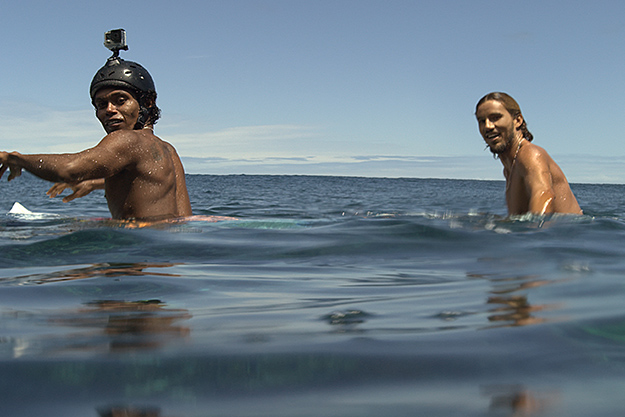
The Shallows
It sets the stage for everything to come because of course it’s an action thriller, and so much of it is these hair’s-breadth escapes, just barely avoiding catastrophe, but it also gives a general sense of precariousness. I wanted to talk also about some of the setpieces, in particular the two hand-to-hand combat scenes, one of which is very claustrophobic and choppy, the other of which is a long sequence shot, very bravura in a different way. Do you get very involved in fight choreography?
I’m very involved, because they have to be about the characters. The first one you’re talking about, which is just a couple of punches, that’s just to show Liam losing. I wanted to see him lose a fight. We’re so used to seeing him and his set of skills, and in this movie this scene operates as a reminder that he’s just a normal, mortal guy, a clever guy, but he can lose. He gets the information he wants, he gets out of the situation in a smart way that uses his knowledge of the train, opening up a door to get out of the fight. We didn’t plan that much because we wanted to keep it realistic, almost like you don’t know what’s going to happen. A couple of punches, a couple of holds, enough to get across this information, but it was not planned at all, we just winged it.
Usually I operate the camera when I’m doing in action sequences, and it’s because I sort of know what’s going to happen, and I don’t want any mistakes. The other one, the long shot, it’s really for practical reasons, to do an action scene in a shot that lasts a couple of minutes. It’s not to say “Oh my God, look at what I can do,” it’s to create tension. I was going to end that with Liam kind of halfway out the window and a train coming towards him, and I didn’t want to cut at that moment, you know? So, working backwards from that problem, thinking I don’t want to change the style of the fight, I don’t want to cut in that moment, because I don’t want to cut to the point-of-view of a train conductor on the other side. I wanted to keep in the shot, so why not do the whole thing in one shot? And in the end I didn’t have to do the typical brakes screeching, lights-becoming-brighter thing. That was why. And, practically, actually, to do a very rehearsed action scene that lasts a couple of minutes is actually easier in many ways to shoot. Well, it’s not easier. It’s less time. If I did the coverage for the entire fight scene I could be spending three days, and that eats into other things.
But this way you have to think about it, you can’t make any mistakes, you have to know the choreography well in advance, you have to come in and rehearse with the cameras, you have to make sure you can open the train in certain moments and that that works, to open walls for big camera moves. There’s a lot more prep and a lot more work but then you’re done. And it works, hopefully it works. But I never do anything visually unless it makes sense in terms of the rhythm that I’m working towards, and hopefully it pays off in the way intended.
Film history has a lot of instances of shooting suspense on a train. Were there any examples that you were looking at going in?
Train movies? No. There are so many wonderful train movies, but the best ones all have their unique voice: Runaway Train, The Lady Vanishes, Snowpiercer. They’re all very different, because I think each train is different. For me it was most useful having done Non-Stop, it was a big learning experience, I learned the things you can do shooting in this kind of space. This one was a bit more complicated because in a plane you can pull the shades and there’s nothing, no visual effects, you don’t have to create this sense of movement. Here you get light changing, the environment outside the train constantly changing. And obviously we weren’t shooting in a moving train, we were on a soundstage with a blue screen, but we needed to always know what the environment outside looked like, if the train was turning or if it wasn’t, where the sun was. Is it on the right, is it low or is it high? So that took a lot more planning.
Also, I only had one carriage. One carriage that I needed to make look like six carriages. So we changed the interior and the people around. Basically the whole movie was shot in one carriage with a studio backdrop, you know? But I had the movie in my head, so I was like, “Okay, let’s shoot all of carriage one.” So there are 10 scenes in carriage one. So, okay, dress for carriage one. Scene one, Liam comes around, sits down here, gets up and leaves. Okay, done, now scene 34 is the next time we’re here. Liam has changed, the people are different, and so on. We shot it completely out of order, for practical purposes. It took a lot of planning, to know exactly where everyone was sitting and to keep tabs on everyone, but if I do my job right, nobody’s going to notice any of this. And I enjoy that, those puzzle-solving things, with continuity or whatever. In Non-Stop it was the same thing.
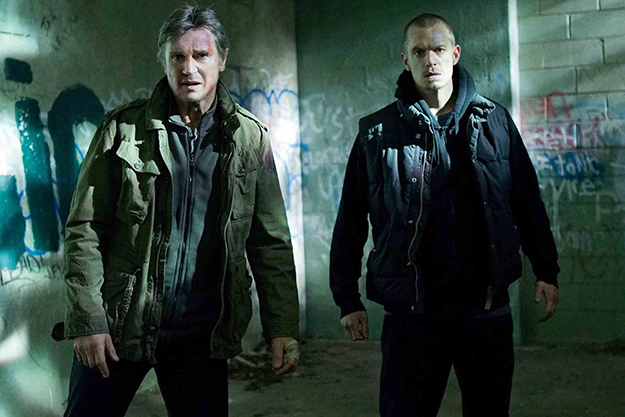
Run All Night
The movie also reminds me a little of Run All Night, in that they’re both movies that are really concerned with Greater New York cartography, like “How long does it take to get from this pub on 42nd St. to Madison Square Garden while a Rangers game is letting out, and how do I time my break so I can lose these guys who are tailing me?” You do a little fudging, a few embellishments, but you’re sticking pretty closely here to the Metro North Hudson Line.
And in a movie that was shot in London. Well, we went to New York for a couple of days. I mean, I lived in New York. I live in every city that I end up making a movie. When I was making Unknown I was living in Berlin, so it was important to me to show the city as it is. And there are some things in that movie that only people from Berlin notice. The same thing with New Yorkers and Run All Night. On this, I had no idea about the Hudson Valley line when I started the movie, but it’s my job to know, to go and ride it a few times and know how it works and get an overall sense for it so I can re-create that. And sometimes you can change things and stylize things a little more, but in the case of New York or Berlin there’s no need to. The reality is much better than anything you can come up with, and when I’m shooting a city like that, I try to respect it as much as I can.
I didn’t want to change the train. I wanted a used train. I wanted the train to be a train that’s been through a lot, like my main character. I wanted to put people in the train who are young and vibrant, and for them this train is a disgusting place to be. And there are other people who love the train—which is reality, you know? I didn’t want to have Liam in a shiny new train, you know? We had him in a shiny new airplane in Non-Stop, and in that case it was okay, because he had to kind of reconnect with the world around him, he’s out of step. In this one, he is the train. They’ve both been through a lot of stuff, they both have character, they both own it.
Nick Pinkerton is a regular contributor to Film Comment and a member of the New York Film Critics Circle.



